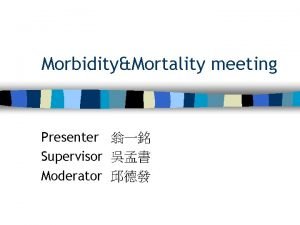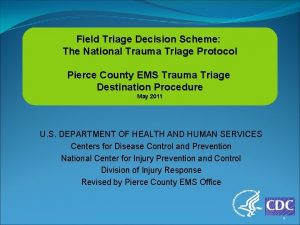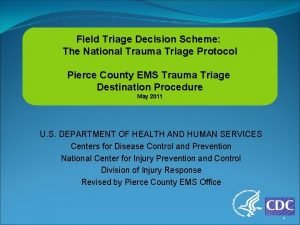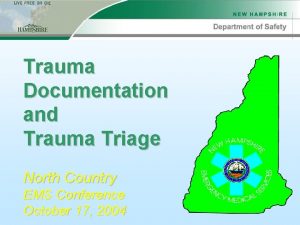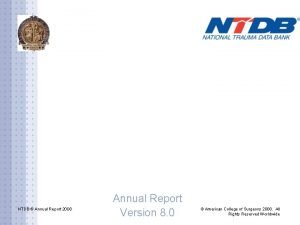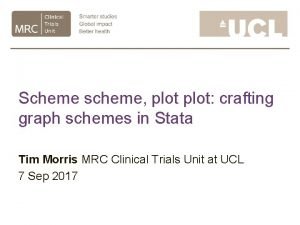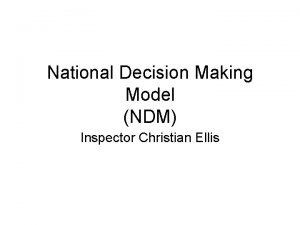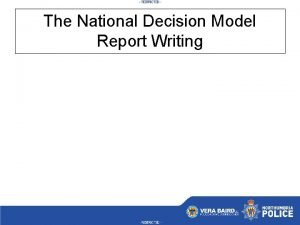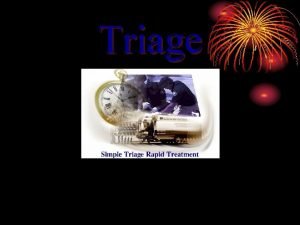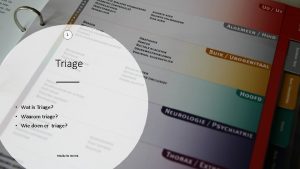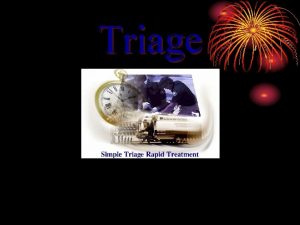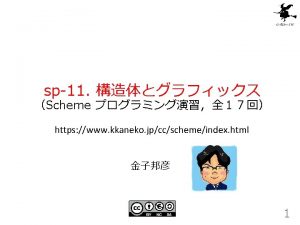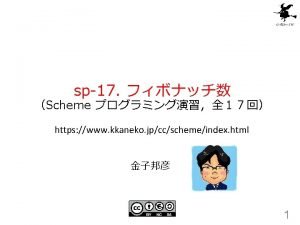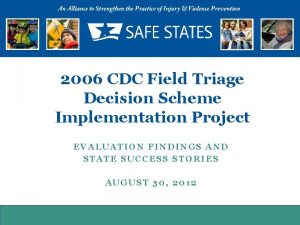Field Triage Decision Scheme The National Trauma Triage





























- Slides: 29

Field Triage Decision Scheme: The National Trauma Triage Protocol Pierce County EMS Trauma Triage Destination Procedure May 2011 U. S. DEPARTMENT OF HEALTH AND HUMAN SERVICES Centers for Disease Control and Prevention National Center for Injury Prevention and Control Division of Injury Response Revised by Pierce County EMS Office 1

Objectives Review the importance of accurate field triage Review the history of the American College of Surgeons Field Triage Decision Scheme Discuss changes in the 2006 Field Triage Decision Scheme / Trauma Triage Procedure in Pierce County Review the list of Trauma facilities accessed by Pierce County EMS agencies 2

Source: National Center for Injury Prevention and Control, Centers for Disease Control and Prevention. Web-based Injury Statistics Query and Reporting System. Ten Leading Causes of Death, 1999 -2004.

History of the Decision Scheme The American College of Surgeons-Committee on Trauma (ACS-COT) developed guidelines to designate “trauma centers” in 1976 - Set standards for personnel, facilities, and processes necessary for the best care of injured persons Studies showed mortality reduction in regions with trauma centers

History of the Decision Scheme AKA- the Triage Decision Scheme It is discussed in the PHTLS course regarding how to decide where to transport trauma patients 5

History of the Decision Scheme The Decision Scheme has been revised four times (1990, 1993, 1999, 2006) In 2005 -2006 the Centers for Disease Control and Prevention (CDC), with support from the National Highway Traffic Safety Administration (NHTSA), convened the National Expert Panel on Field Triage 6

History of the Decision Scheme National Expert Panel on Field Triage Membership National leadership, expertise, and contributions in the realm of injury prevention and control Members EMS Providers and Medical Directors Emergency Medicine Physicians and Nurses Trauma Surgeons Public Health Federal Agencies Automotive Industry 7

Why this Decision Scheme is Unique Takes into account recent changes in assessment and care of the injured patient in the U. S. Adds views of a broader range of disciplines and expertise into the process 8

Purpose This Decision Scheme was revised to facilitate more effective triage and better match trauma patients’ conditions with the medical resources best equipped to treat them 9

Published: January 2009 Available for free at: www. cdc. gov/Field. Triage 10

“ If you are severely injured, care at a Level I trauma center lowers your risk of death by 25%” Source: Mac. Kenzie EJ, Rivara FP, Jurkovich GJ, et al. A national evaluation of the effect of trauma-center care on mortality. N Engl J Med. 2006 Jan 26; 354(4): 366 -78.

Field Decision Scheme Triage : The National Trauma Triage Protocol 12

Prehospital Trauma Triage (Destination) Procedure amended by Pierce County EMS

Step 1 Physiologic Criteria STEP 2 Anatomy of injury 14

STEP 1 MEASURE VITAL SIGNS & LEVEL OF CONSCIOUSNESS Changes: Glasgow Coma Scale < 14 Systolic BP <90 mm. Hg <20 breaths in infant < one year HR criteria removed Take patient to NEAREST Level I or II within 30 minutes Apply “Trauma ID Band” 15

Step 2 Anatomic Criteria STEP 3 Mechanism of Injury 16

STEP 2 ASSESS ANATOMY OF INJURY Changes: Penetrating injuries to extremities proximal to elbow and knee Pelvic fractures Open or depressed skull fractures Paralysis ‘Burns’ moved Take patient to NEAREST Level I 17

Step 3 Mechanism of Injury Criteria STEP 4 Assess Special Patient or System Considerations 18

STEP 3 ASSESS MECHANISM OF INJURY & EVIDENCE OF HIGHENERGY IMPACT Modified: Falls: Adults: >20 feet (one story = 10 feet) Children: >10 feet, or 2– 3 times the child’s height Take patient to NEAREST appropriate trauma center within 30 minutes Apply “Trauma ID Band” to patient removed 19

STEP 3 ASSESS MECHANISM OF INJURY & EVIDENCE OF HIGHENERGY IMPACT “High energy transfer situation” was changed to “high-risk vehicle crash” Intrusion modified to >12 inches at occupant site or >18 inches at any site Rollover was removed Vehicle telemetry data consistent 20

STEP 3 ASSESS MECHANISM OF INJURY & EVIDENCE OF HIGHENERGY IMPACT “What is vehicle telemetry? Combination of telematics and computing Integration of vehicle’s electrical architecture, cellular communication, GPS systems, and voice recognition Can notify of exact location of crash Can enable communication with occupants Can provide key injury information to providers regarding force, 21

STEP 3 ASSESS MECHANISM OF INJURY & EVIDENCE OF HIGHENERGY IMPACT “Pedestrian hit. . ” changed to “Vehicle v. Pedestrian/Bicyclist Thrown, Run over, or with Significant (>20 mph) Impact” “Motorcycle , ATV bicycle accident “changed to “Motorcycle crash >20 mph” 22

STEP 3 ASSESS MECHANISM OF INJURY & EVIDENCE OF HIGHENERGY IMPACT Removed Extrication time >20 minutes Rollover 23

Step 4 Special Considerations 24

STEP 4 ASSESS SPECIAL PATIENT OR SYSTEM CONSIDERATIONS Modified Age Older adults: Risk of injury/death increases after age 55 Children: Should be triaged preferentially to pediatric capable trauma centers Pregnancy – 2 nd/3 rd Trimester Pregnancy changed to read “Pregnancy > 20 weeks” 25

STEP 4 ASSESS SPECIAL PATIENT OR SYSTEM CONSIDERATIONS Added Anticoagulation and Bleeding Disorders Burns - moved from Step 2 Time Sensitive Extremity Injury End-Stage Renal Disease Requiring Dialysis 26

STEP 4 ASSESS SPECIAL PATIENT OR SYSTEM CONSIDERATIONS Removed/ Hostile environment (heat or cold) Medical illness (such as COPD, CHF) Diabetes Mellitus Morbid obesity Immunosuppression 27

Trauma Centers used by Pierce County EMS agencies facility Allenmore Good Sam Madigan Mary Bridge St. Anthony St. Clare St. Joseph Tacoma General level n/a III II P II IV IV II II facility level Harborview I Auburn Regional III Harrison Memorial III St. Peter III St. Elizabeth V St. Francis IV

For more information go to www. cdc. gov/Field. Triage Any Questions ? ? 29
 Field triage decision scheme
Field triage decision scheme Neck mass
Neck mass Field triage decision scheme
Field triage decision scheme National trauma triage protocol
National trauma triage protocol Objectives of decision making
Objectives of decision making Dividend decision in financial management
Dividend decision in financial management Miemss trauma decision tree
Miemss trauma decision tree National trauma data bank annual report 2020
National trauma data bank annual report 2020 3 domain scheme and 5 kingdom scheme
3 domain scheme and 5 kingdom scheme Stata graph schemes
Stata graph schemes Pyramid scheme vs ponzi
Pyramid scheme vs ponzi Decision tree and decision table
Decision tree and decision table Andy field decision tree
Andy field decision tree National 5 pe portfolio
National 5 pe portfolio Colour code
Colour code National apprenticeship promotion scheme
National apprenticeship promotion scheme National agriculture insurance scheme
National agriculture insurance scheme 21lwuy8i6hw -site:youtube.com
21lwuy8i6hw -site:youtube.com Field dependent vs field independent
Field dependent vs field independent Field dependent vs field independent
Field dependent vs field independent Distinguish between magnetic and nonmagnetic materials
Distinguish between magnetic and nonmagnetic materials E field h field
E field h field Database field types and field properties
Database field types and field properties Field dependent definition
Field dependent definition Magnetic field
Magnetic field Police national decision making model
Police national decision making model Police national decision model
Police national decision model National field service automation
National field service automation Hát kết hợp bộ gõ cơ thể
Hát kết hợp bộ gõ cơ thể Ng-html
Ng-html

